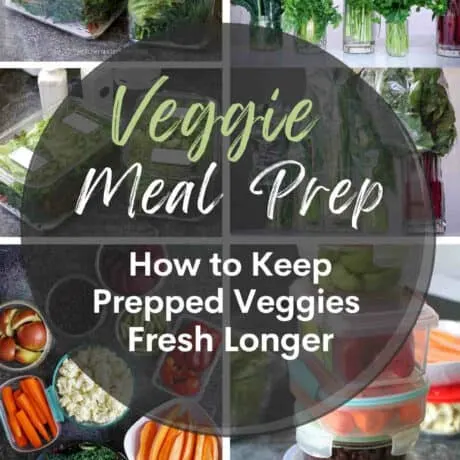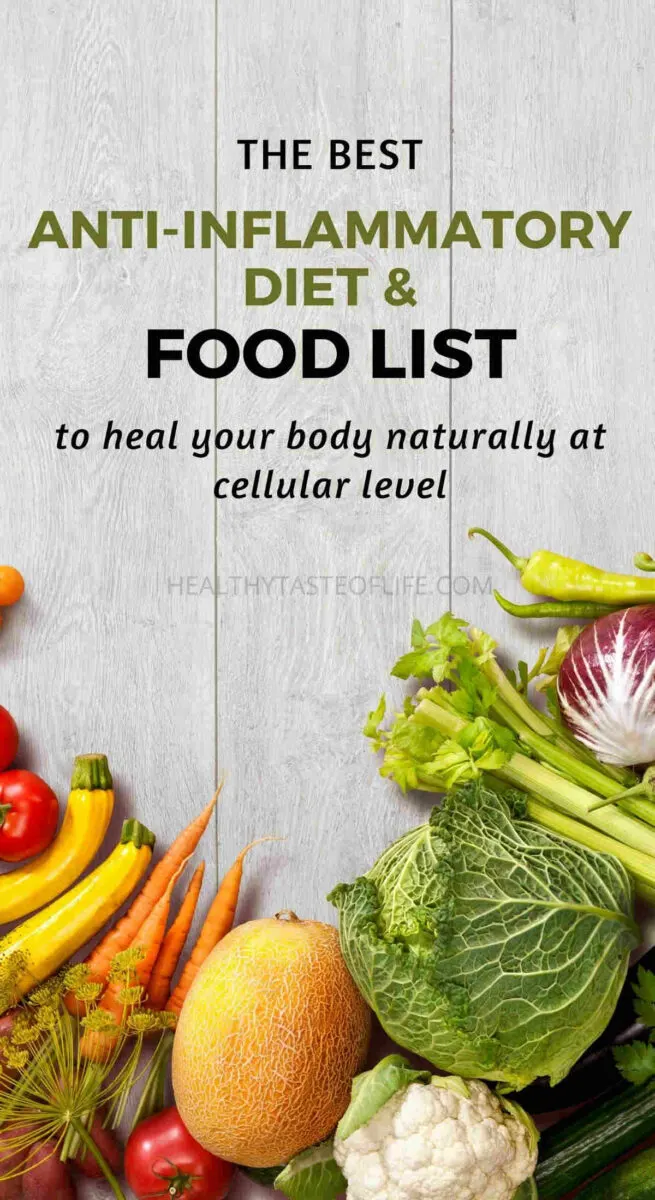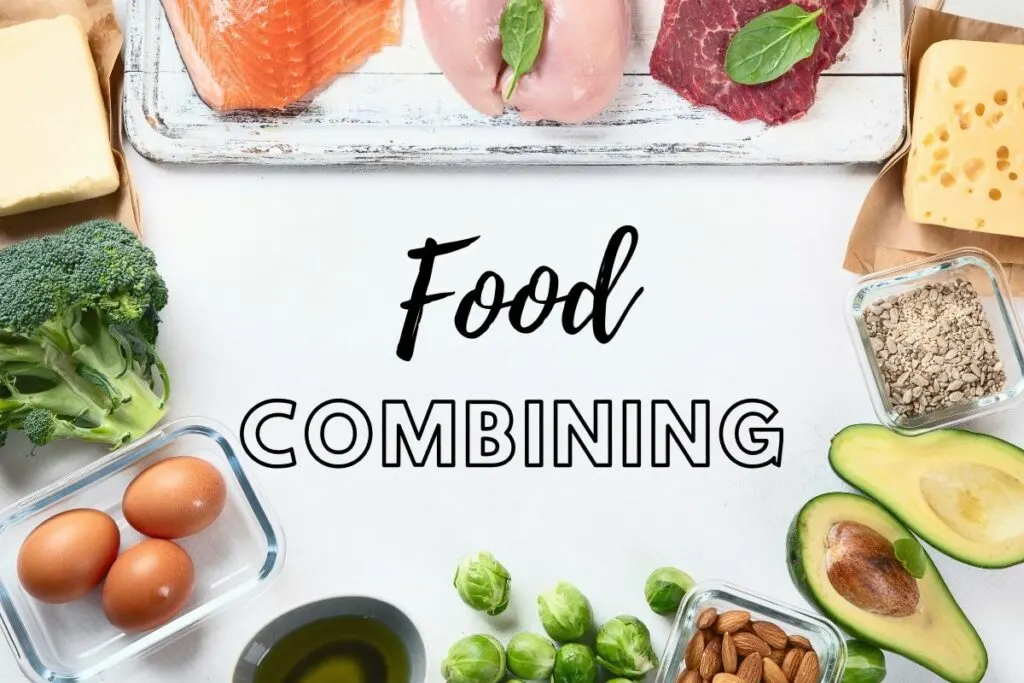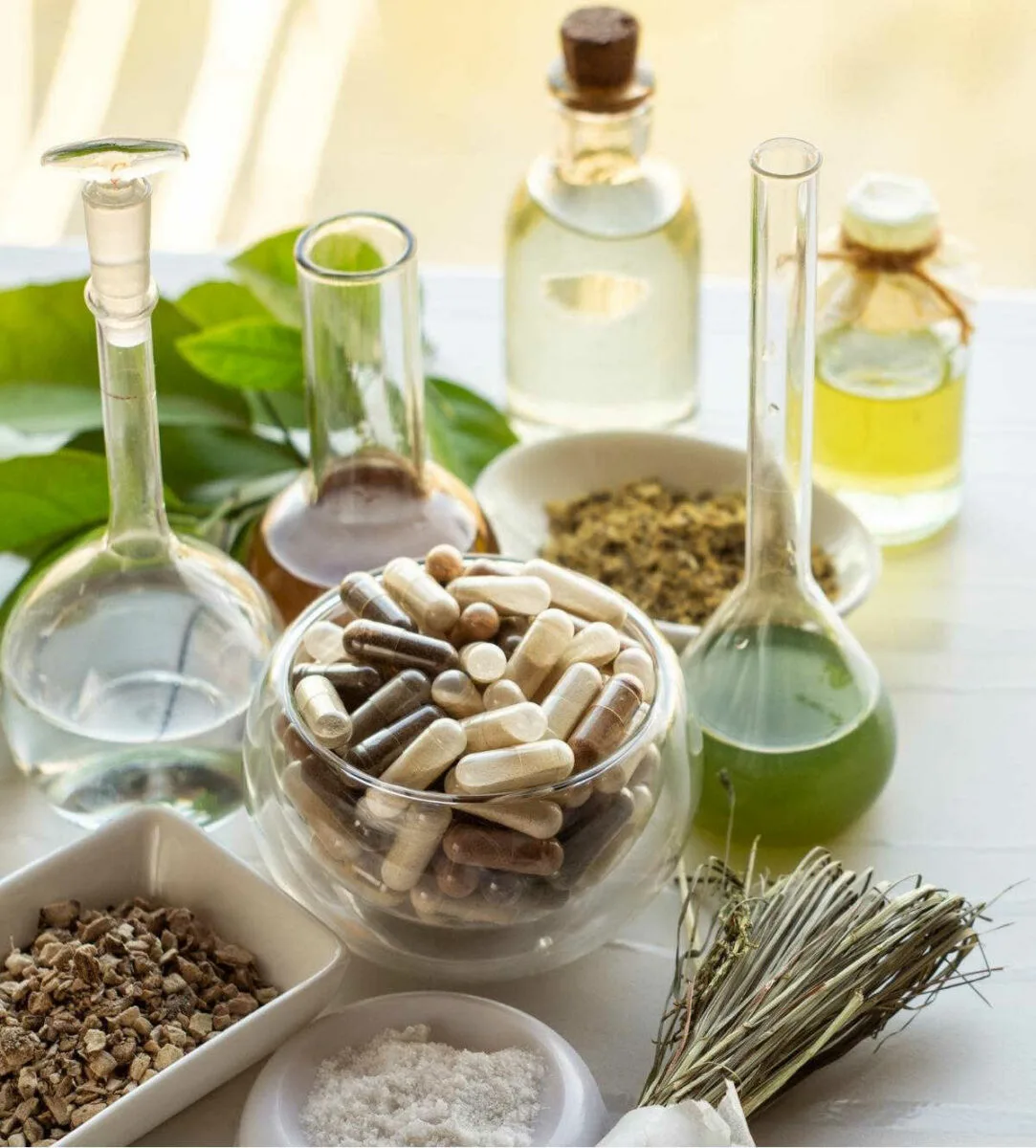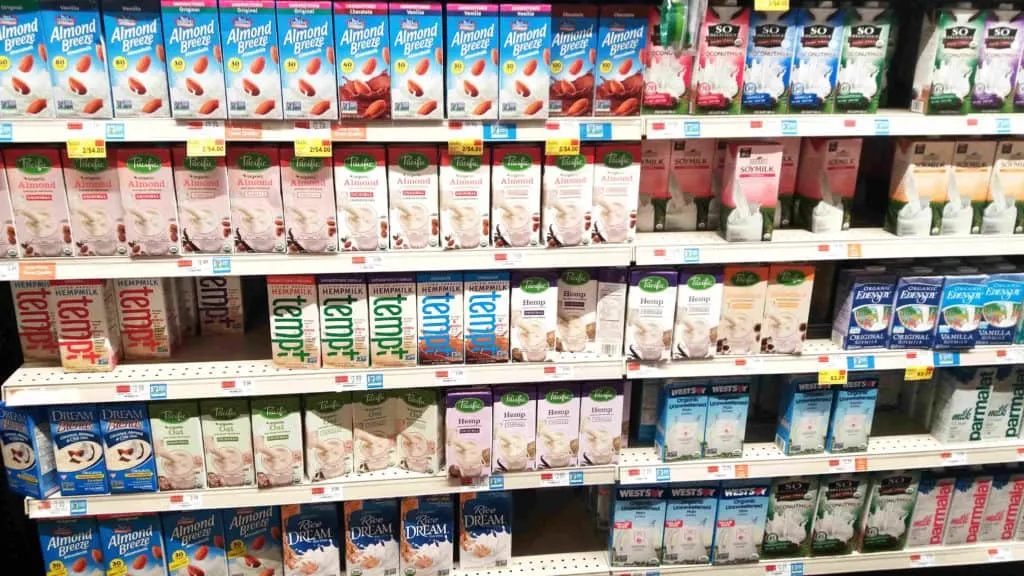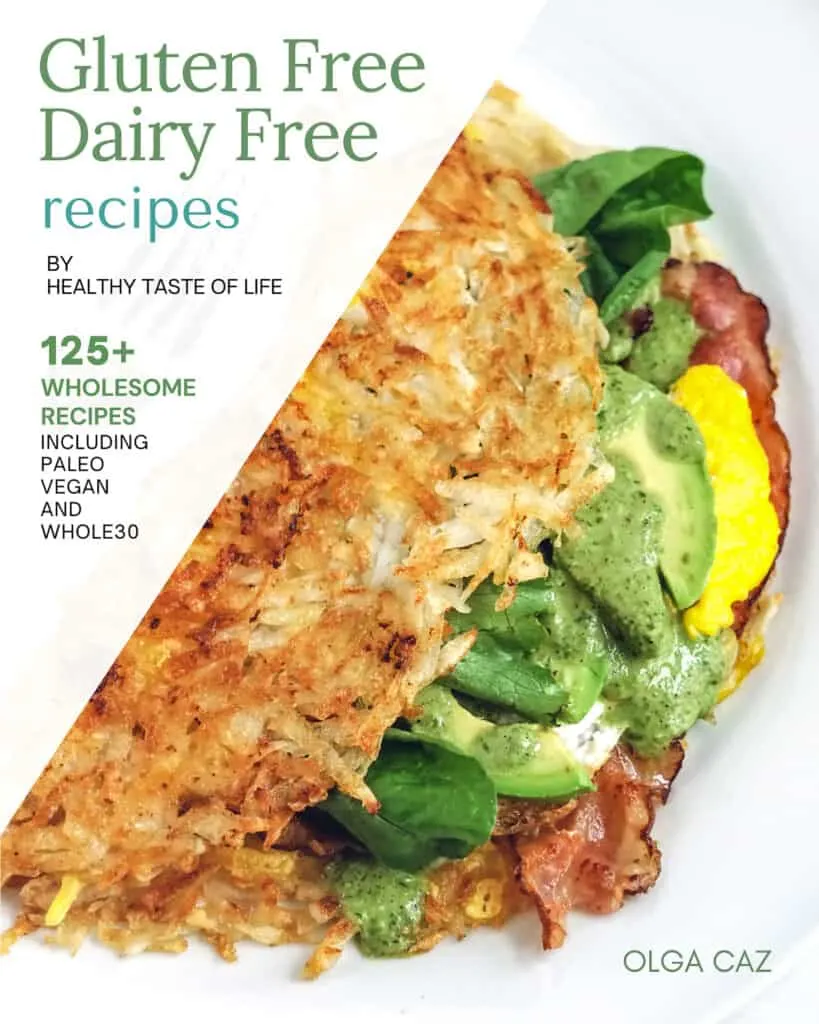Veggie meal prepping is a great way to make sure you have healthy meals with lots of vegetables ready to go for the week. But if you don’t want to eat the same thing every day, meal prepping vegetables can help you mix things up and incorporate a variety of veggies for a meal.
The only problem is that chopped veggies can spoil quickly if not stored properly. In this blog post, we will discuss how to meal prep vegetables and tips to keep cut veggies fresh longer so you can enjoy a variety of healthy meals throughout the week!
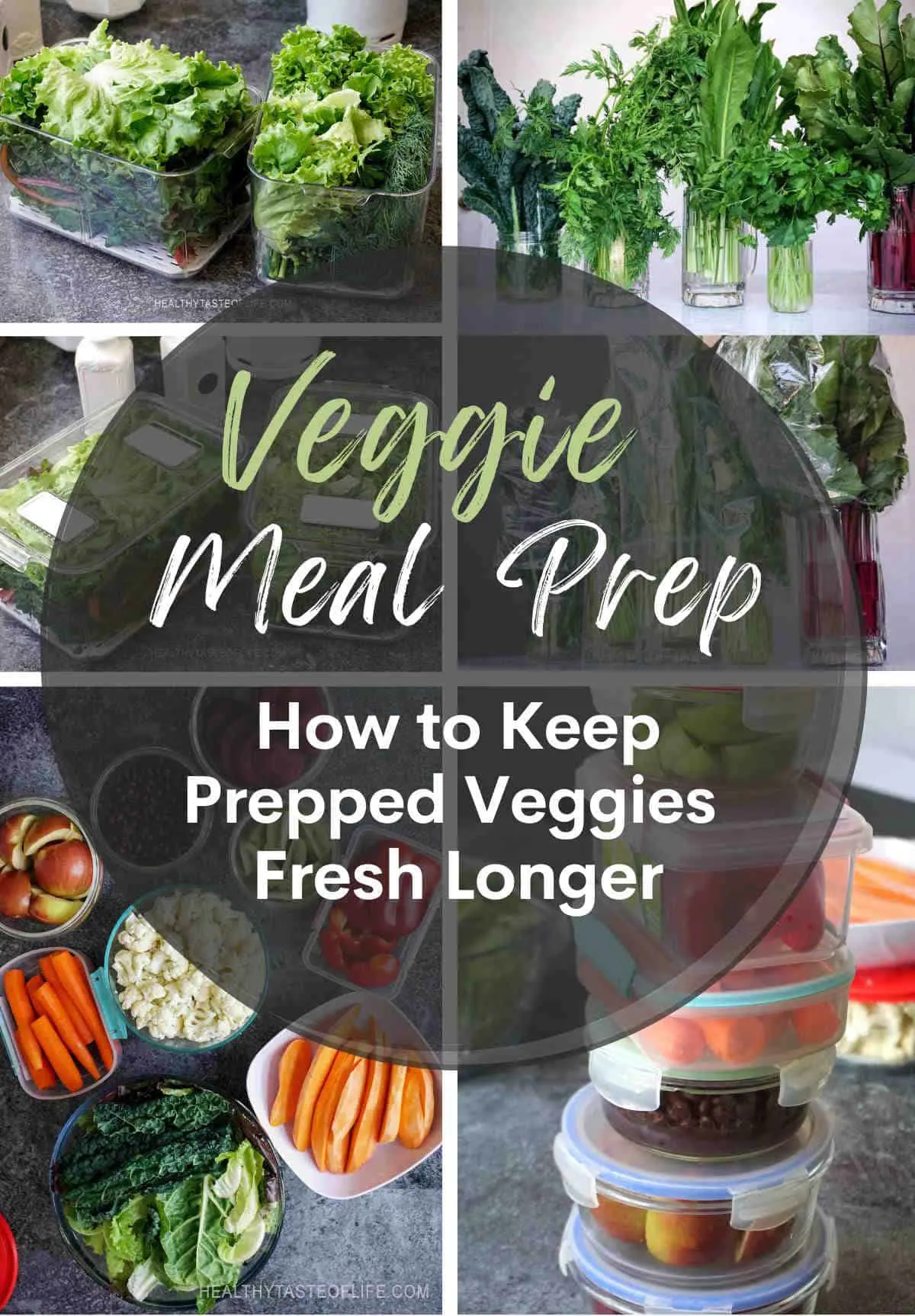
Related: Choosing The Healthiest Cookware With Safest Materials
Let’s be honest no matter how much you want to eat cleaner and healthier you’re not going to do that until you actually see your veggies clean, peeled and cut (ready to be eaten). Otherwise you’ll just grab a packaged snack – because it’s quicker and readily available.
Many times I avoided meal prepping because I knew that the best food is freshly cooked from scratch. But, I’m a lazy person and this conflicts so much with my beliefs. To find a middle ground I decided to try ingredient prepping instead of meal prep – hence – meal prepping veggies. Keeping the produce (fruits and vegetables) fresh longer was the key.
Meal Prepping Veggies
Vegetables are an essential part of a healthy diet (especially when you’re trying to eat clean and use food for healing at cellular level) and meal prepping them is a great way to make sure you have plenty on hand to create healthy meals.
When meal prepping veggies, it is important to first wash and dry them thoroughly in order to remove any dirt or bacteria. Then chopping, cutting or storing the veggies whole, is up to you. You can store them fresh or partially cooked in the right container.
Related: The Secret of Good Digestion – Food Combining Chart
How To Prep Vegetables
Not all vegetables are good for meal prepping. Some tend to spoil much faster once prepared than others.
Here are some general guidelines you can use for each method of storing prepped veggies:
- Fresh cut vegetables – can be kept refrigerated for up to 1 week. These are convenient for stir fries or for quick salads like this chickpea and cabbage salad or this creamy coleslaw with avocado.
- Partially cooked vegetables (or cooked) – up to 3 days. You can assemble into quick salads like this cooked pumpkin and beetroot salad or use as side dish for your protein like in my quinoa poke bowl with shrimp.
- Frozen veggies – up to 3 months in the freezer.
Recipe you might like: Butternut Squash and Sweet Potato Casserole
Washing Vegetables For Meal Prepping
Washing your vegetables properly is the most important step in meal prepping them. Sometimes using just tap water is not enough, the bacteria responsible for rapid spoilage can stay on the produce after drying.
When To Wash, Before Or After Storing?
Rinsing the produce with tap water when you bring them home will actually increases moisture and accelerates spoilage, microflora, and mold.
Another problem is that sometimes just washing the produce does not remove the pesticides, the harmful bacteria (when it’s an outbreak) or the wax layer from apples, lemons, oranges and bell peppers (meant to extend their shelf life). Even if they’re organic.
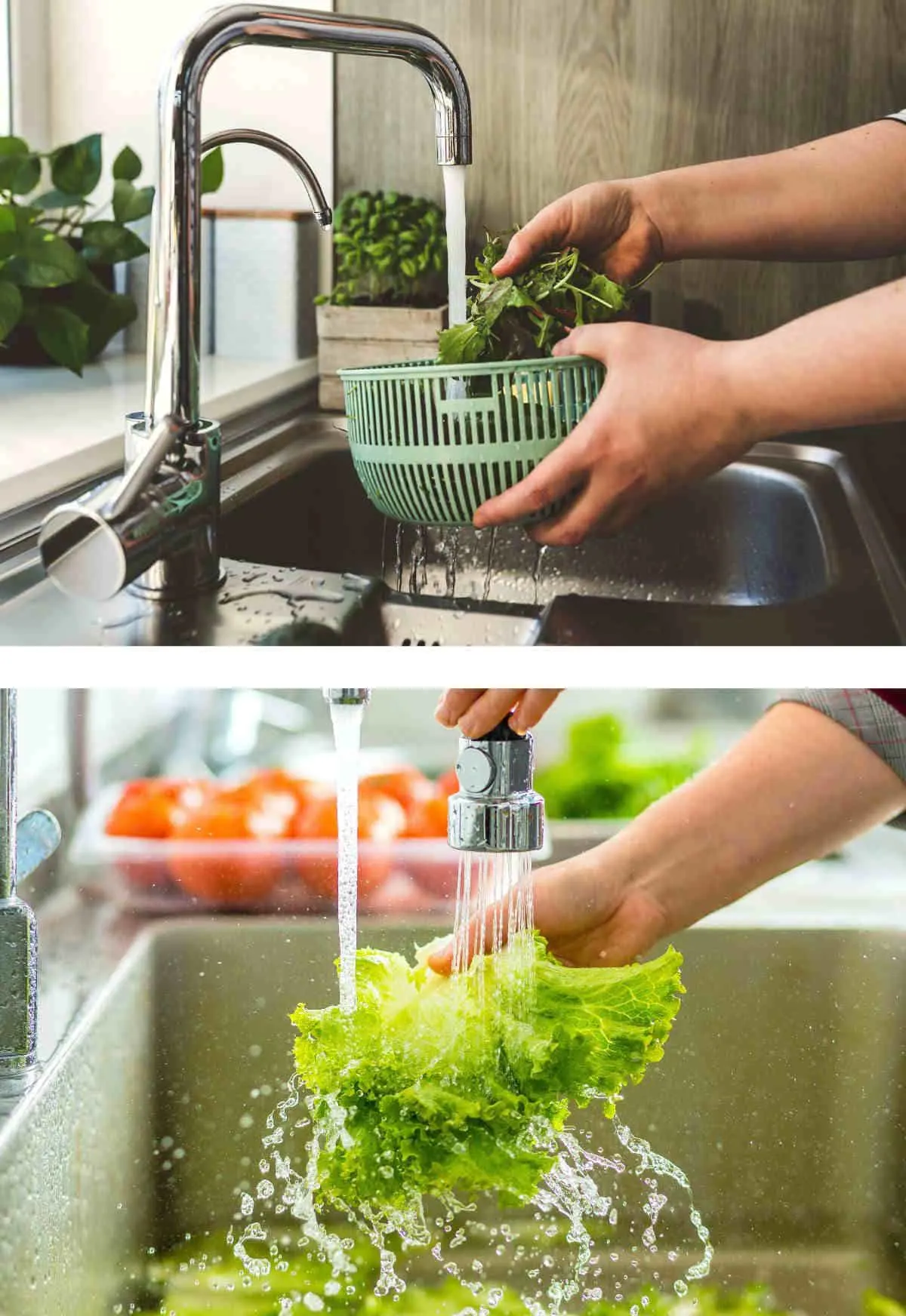
Chemical rinses and other treatments for washing raw produce are often used, especially those pre-washed greens in a plastic box or the baby carrots we all know. But are these washes safe and effective when the fresh produce are porous and could absorb these chemicals?
Since washing fruits and vegetables with soap and detergent is not a great idea, there are more natural ways to disinfect the produce before storing.
Vinegar Water
A solution of one part vinegar to three parts water can help sanitize your veggies and remove any residual bacteria. Just soak in that vinegar water for 20 minutes.
Adding a teaspoon of baking soda to a 4 quart bowl of water is another option. Soak your produce for a few minutes, swish and swirl, then rinse with clean water. Drain, dry, and store as usual.
Ozonated Water
Ozonated water is a great way to wash your meal prep veggies because it’s effective at removing bacteria and doesn’t leave any residual chemicals on the produce. Ozone is considered to be a more potent disinfectant than chlorine, and it works really fast on bacteria, viruses and mold.
Ozone is also particularly effective against E. coli, the food pathogen of most concern to the produce industry. Also it’s great for wax and some external pesticide residue removal [1].
It stays in the water for about 30 minutes (which is enough for killing pathogens) then the ozone converts back to oxygen, making it safe for environment as well.
Ozone, has long been used as a water sanitizer, and ozone-infused cold water is now widely used by the food preparation industry to clean equipment and surfaces that come in contact with food including the food itself. This eliminates the need for sterilization with scalding water or chlorine.
To make ozonated water, you’ll need a ozone generator which can be found online or at some hardware stores. The ozone gas is pumped into water for several minutes, and then this water is used as a rinse or to soak the produce for 10-15 min. Then you can take them out and leave to dry on a piece of paper towel. For leafy greens is best to use a salad spinner to remove the excess water.
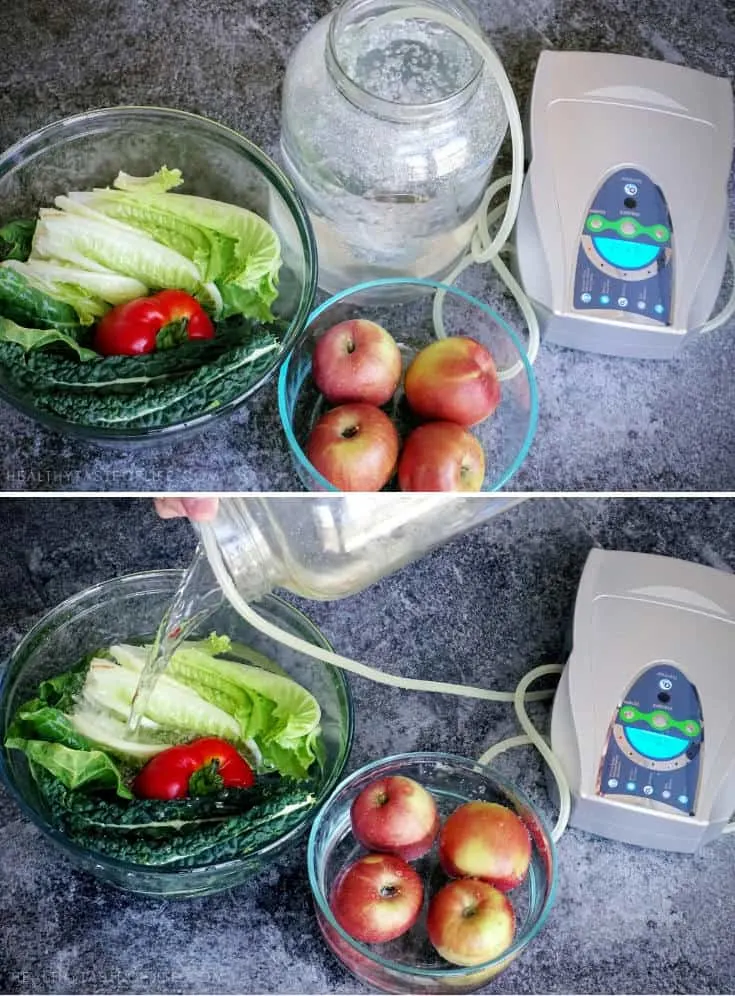
This is my favorite method of disinfecting produce, the food stays fresh and crisp way longer than just washing with tap water. I’m using this method of disinfection for several years now, and I can confirm that it’s worth investing in a ozone generator. It’s so versatile it can be used to disinfect not only food but also air in your house.
How To Store Prepped Veggies
Once disinfected and dried, vegetables can be stored either whole or cut.
But keep in mind that in order to keep your produce fresh longer you need to cut them before you eat them, for two reasons:
- The longer we keep vegetables before using them, the more nutrients they lose, they already spent many days in transport and storage;
- When a fruit / vegetable is cut, it activates enzymes which destroys its own nutrients.
If you really must slice and chop and you don’t care about nutrient loss so much, then take into account that certain vegetables will last about 4 days after being sliced (others a few days longer). As long as you store them in an airtight container and keep them refrigerated.
Recipes To Try: 5+ Nutritious Beetroot Salad Recipes
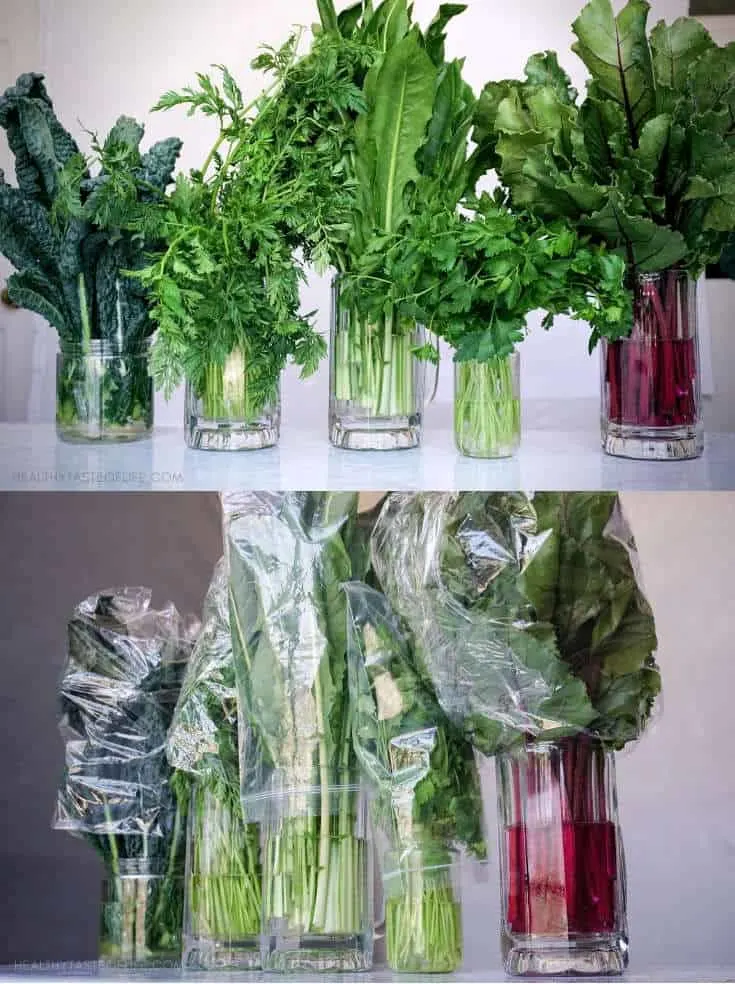
How To Store Leafy Vegetables In The Fridge
Here you have 2 options:
- Keep the greens unwashed, refrigerated, in a glass of water (like flowers in a vase) and covered. They can keep crisp and fresh for up to a week, just wash with tap water before use.
- Or wash the leafy greens with ozonated water (more details below), dry them in a salad spinner (you really need it) and store in a ventilated salad container, in your fridge.
The second method is more convenient as the leafy greens are ready to eat whenever you want, and they keep freshness for much longer than a week.
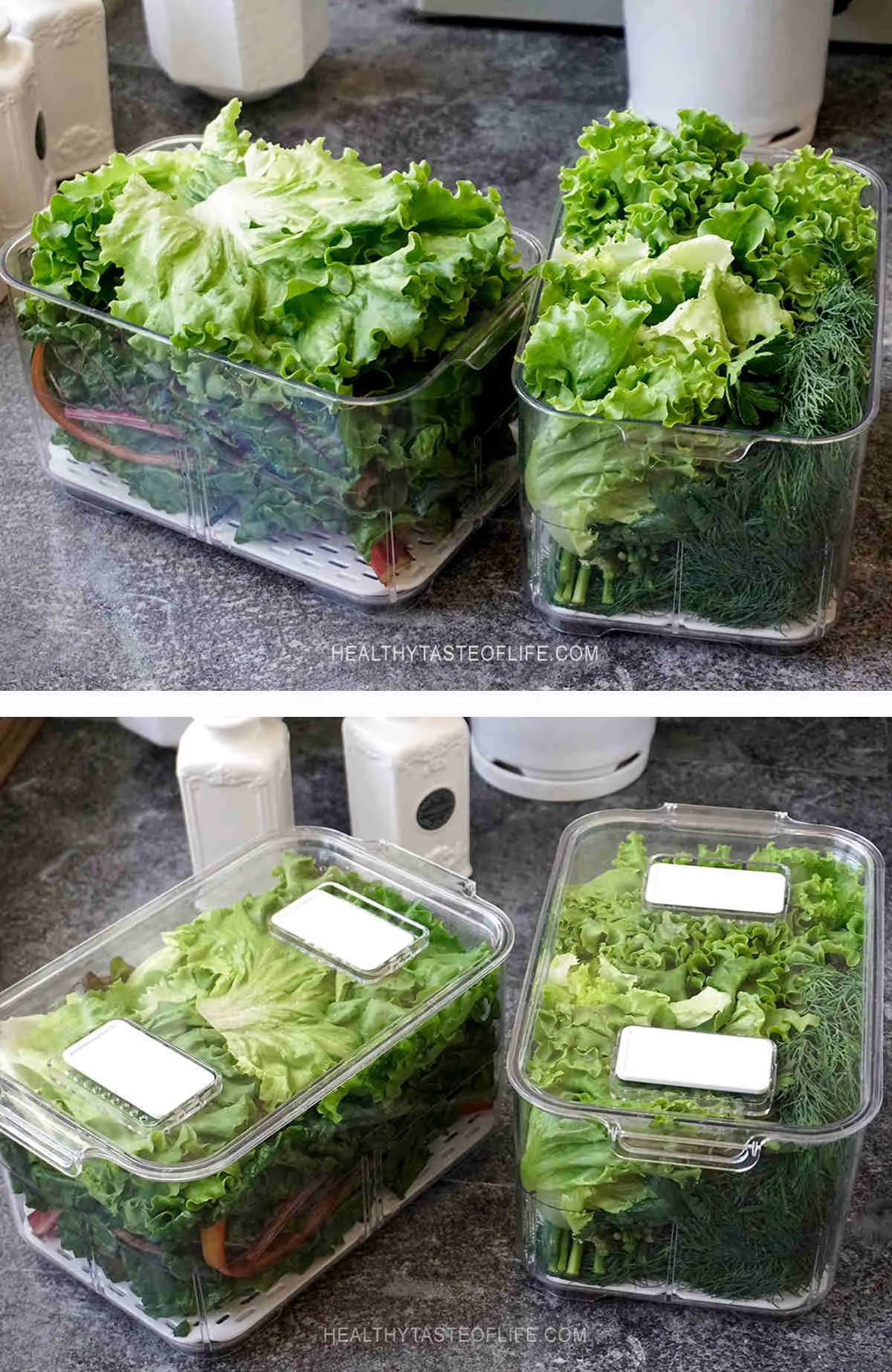

Whenever you want to make a quick salad, just throw your favorite greens in a bowl, chop 2 or 3 of your favorite veggies and drizzle with a creamy salad dressing. Check this cobb salad recipe.
Or you could use the leafy greens to make some green anti-inflammatory smoothies. I know nobody likes to take the time to wash them before blending.
Another way to store aromatic herbs: cut them up, place in an ice tray, add olive oil, and then freeze. Use the cubes whenever you need them quick.
How To Store Root Vegetables
Root vegetables like carrots, sweet potatoes, beets and hard veggies like winter squashes and pumpkins are easily stored in partitioned containers. Wash first (I’m using ozonated water) to remove pathogens from their skin. Then peel if you want. Cutting is optional.
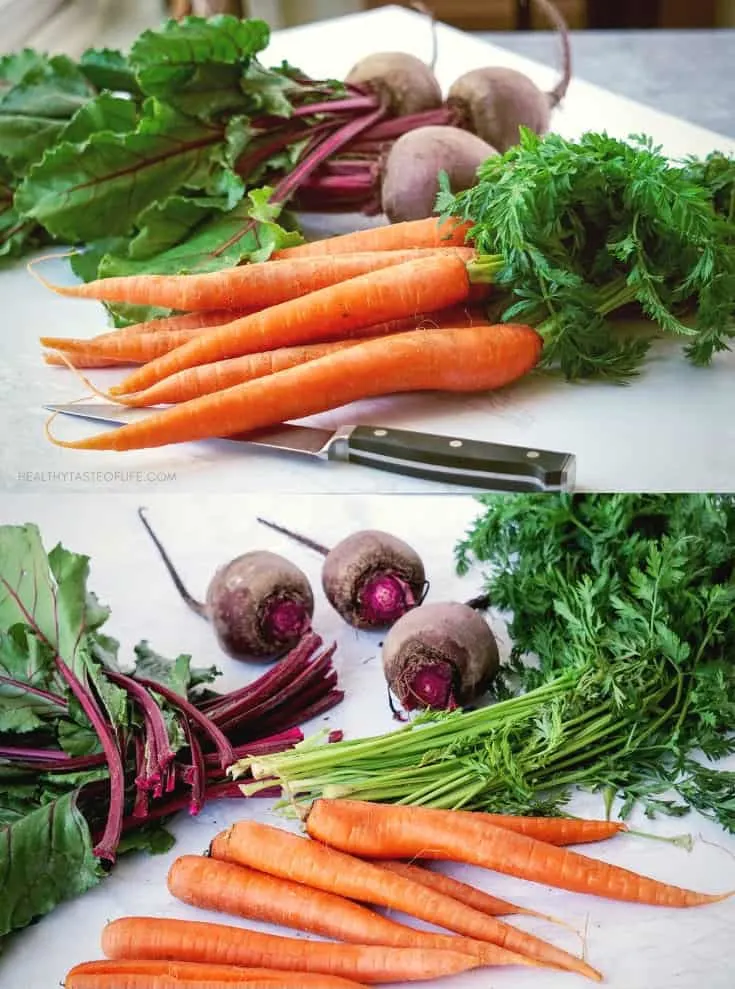
Tips:
- The bigger the chunks the longer they keep fresh.
- Cut the green tops off, otherwise they will draw moisture from the root, and make them loose flavor and firmness.
- Peel the onions and garlic but don’t cut until you’re ready to use them in a meal. Cut onions immediately go bad as they attract the bacteria around the surroundings they are stored in, no matter whether they are stored in the refrigerator or in an open kitchen space. The best way to store peeled onions and garlic is in a ventilated container covered with a paper towel, or leave the lid partially opened. Place it in refrigerator to keep it cool and dry.
Recipe you might want to try: Cabbage Fritters
How To Store Chopped Vegetables
You can store chopped vegetables in meal prep containers, with or without water. Veggies like carrots, celery, parsnip, beets and potatoes keep longer in a moist environment.
If you choose to store them in water, make sure to:
- Use filtered water, or at least boiled and cooled tap water. The chlorine in the tap water will make your veggies go bad faster.
- Change the water every day or every two days.
If you’re meal prepping for the week, storing some of your chopped veggies without water is also possible, just use an airtight container for chopped cabbage, cucumber, sweet potatoes, beets and winter squashes.
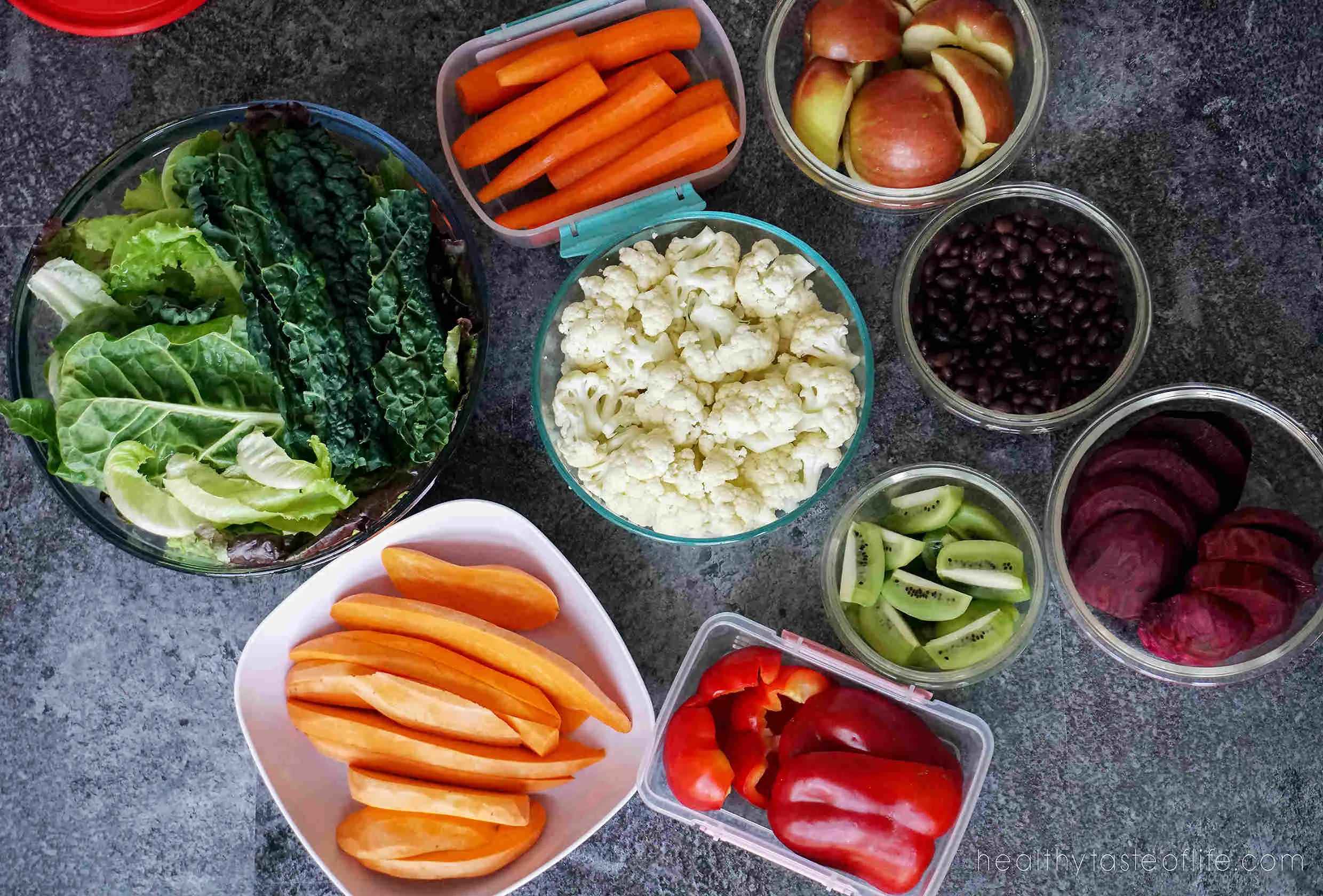
Chopped Vegetables That Need Ventilation
Some cut vegetables don’t like airtight containers, they need to breathe to maintain freshness and so should be stored in ventilated containers. These veggies include broccoli (cut florets), Brussels sprouts (halved or quartered), cauliflower (florets), bell peppers, cubed summer squashes, leafy greens.
Asparagus – is an exception, the best way to store it is like flowers, upright in a glass of water (~1 inch at the bottom) and covered with a plastic bag.
Recipe you can try: Roasted Brussels Sprouts And Asparagus With A Tangy Sauce
When it comes to keeping mushrooms fresh – is best to let them breathe. Storing in air-tight containers or plastic bags will cause condensation and speed spoilage. Instead, place mushrooms in a paper bag (unwashed), just be sure to leave the top open or use the original packaging from the store.
Recipe to try: Healthy Creamy Mushroom Soup
Vegetables that are best kept whole/uncut (due to rapid spoilage or color change): eggplant, tomatoes, white potatoes, cucumber and celery.
Best Vegetables For Meal Prep
- Sweet potatoes (washed and peeled);
- Carrots (washed and peeled);
- Winter squashes and pumpkin (washed, peeled, cut);
- Broccoli (washed, dried and cut);
- Cauliflower (washed, dried and cut);
- Leafy greens (washed, dried and stored in airtight container);
- Cabbage (washed, cut or shredded);
- Bell peppers (washed, cut);
- Green beans (washed, ends trimmed, dried);
- Fennel (washed and cut);
- Summer squashes (washed, whole);
- Onion, garlic (peeled, whole);
- Cucumber (washed, whole);
- Tomatoes (washed, whole).
I hope these meal prepping vegetables will help you embrace the healthy eating lifestyle more easily and save you time and money!
What are your favorite meal prep veggies? Let me know in the comments below!
And don’t forget to subscribe to my mailing list for more tips and recipes!
Disclaimer: The information, including but not limited to, text, graphics, images and other material contained on this website are for informational purposes only and not intended for medical advice. Please refer to my full disclaimer for more info.
Related Articles
©HealthyTasteOfLife. Content and photographs are copyright protected and need prior permission to use. Copying and/or pasting full recipes to other websites and any social media is strictly prohibited. Sharing and using the link of this recipe is both encouraged and appreciated!

